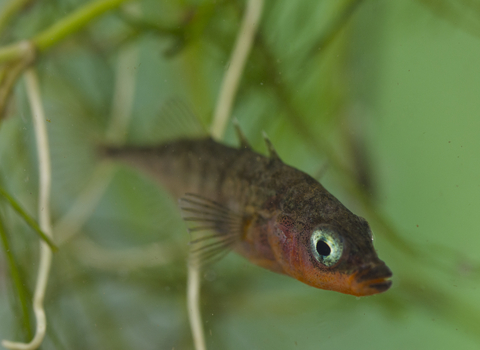
Three-spined Stickleback ©Jack Perks
Three-spined stickleback
A diminutive but aggressive predator, the three-spined stickleback hunts tadpoles and small fish. It is also known for fiercely protecting its nest of eggs until they hatch. Look for it in ponds, lakes and rivers.
Scientific name
Gasterosteus aculaeatusWhen to see
January to DecemberSpecies information
Category
Statistics
Length: 4-7cmWeight: 1g
Average Lifespan: 3-5 years
Common.
Habitats
About
The three-spined stickleback is a small fish found in ponds, lakes, ditches and rivers. It is an aggressive predator, feeding on invertebrates and other small animals, including tadpoles and smaller fish. In the spring, the male develops a bright red throat and belly and performs a courtship dance to attract a mate. He builds a sheltered nest out of vegetation, under which the female will lay up to 400 eggs. The male then defends the nest from other fish until the young hatch up to four weeks later. The three-spined stickleback is the fish that is most likely to be caught when pond-dipping.How to identify
The three-spined stickleback has a brownish back and silvery sides and belly. In spring, males develop a red throat and belly, and bright green flanks. Living up to its name, it can be identified by the three sharp spines on its back.Distribution
Widespread.Did you know?
Marine three-spined sticklebacks migrate out to sea in the winter, returning to freshwater rivers in the spring to spawn. Freshwater three-spined sticklebacks tend to be more sedentary, staying in the same place for their whole lives.Stickleback nest (https://vimeo.com/417948632)
Male stickleback encouraging a female to lay eggs in his nest © Tom Hibbert
